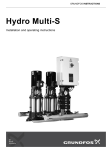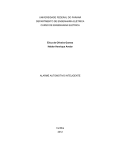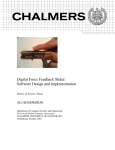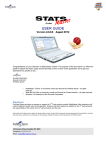Download MOBILE PHONE BASED REMOTE CONTROL SYSTEM FOR
Transcript
ISSN 1691-5402 ISBN 978-9984-44-071-2 Environment. Technology. Resources Proceedings of the 8th International Scientific and Practical Conference. Volume I1 © Rēzeknes Augstskola, Rēzekne, RA Izdevniecība, 2011 MOBILE PHONE BASED REMOTE CONTROL SYSTEM FOR FURNACE AUTOMATION Edmunds Visockis, Janis Zalans, Artis Teilans, Gundars Valgis Rezeknes Augstskola, Faculty of Engineering Latgale Sustainable Development Research Institute Ph.: +371 64625264; e-mail: [email protected] Abstract. Nowadays, an increasing role in various technologies holds electronic devices that automate the various systems to facilitate people's daily life. This publication describes one of those types of automation capabilities, as a control system using mobile phones and mobile communications. Innovative approaches for the modification can be used for various purposes, such as a room or vehicle security alarm systems, remote management for various processes, the heating system furnace firing, the combustion process control, as well as many other remote management and control purposes. Keywords: Remote Control Systems, GSM communications, Microcontroller. Introduction The research prototype device described in this publication was designed for the control of solid fuel (firewood, charcoal, briquettes, etc.) furnace firing process through the strictly defined content of a mobile phone short message service (SMS). Remote control is realized by exchange with text messages between the mobile phone and the embedded SIM card of furnace unit. The implemented approach provides execution of received SMS commands, as well as notification of a sender about the furnace operational status or response to the received commands. The research prototype of the remote control system is implemented as a segregated unit and useable for improvement of already existing solid-fuel furnace heating systems, or for design of new models of furnaces and heating equipment. Control methods and system design Fig. 1. Experimental device assembly blocks (modules) The research prototype device is divided into several blocks (modules) in order to more clearly be able to view an assembly operation, and to easy carry out a separate block for configuration and maintenance work if needed. The blocks are: user, communication module, the control module and the device that will be operated, in our case – furnace. Assembly of the individual blocks is shown in Figure 1. Each of these blocks is an indispensable and vital element in equipment, required for device to work properly. Even one malfunctioning module affects device’s overall operation. 187 Visockis E., Zalans J., Teilans A., Valgis G. MOBILE PHONE BASED REMOTE CONTROL SYSTEM FOR FURNACE AUTOMATION Let's take a brief look at all device modules: User. This part consists of a human and a mobile phone. Correct human action is required for successful functioning of the device. The human has to make decisions about device’s performance and control and, by using corresponding commands in the form of an SMS, send the commands to the device, which device will try to execute and then notify the user back about command execution status. Communications module. This part consists of GSM module, SIM card, antenna and battery. This module is responsible for receiving commands from the user and sending reports back to the user. Control module. In this part of pilot study as a key component in this block was used microcontroller ATMEGA8. Control module is responsible for managing communications module, instruction receiving and processing as well as status checks and reporting back to the user. The main task of this block in our experimental case is the furnace firing and management. The device, which will be managed. Innovative remote firing and room heating system uses a specially designed solid-fuel furnace, which ensures 100% fire safety without human presence. Firing burner is placed in specially designed place inside the furnace. User fills furnace with the proper fuel to ensure that firing will be accomplished. When it’s time to remotely kindle the furnace, user sends appropriate command to the control module from mobile phone. Control module then will read the fuel combustion process status and if no problems are detected, furnace firing is executed by a specified sequence algorithm: 1. Open flue damper and turns on smoke pump (if it’s built into the system); 2. After a certain time kindle the fuel; 3. After a certain time read the temperature on the heating element surface and temperature in the heated room. If the algorithm by any conditions is not fulfilled in a specific order, fuel ignition process is stopped. Information about the ignition, fuel combustion and room warming processes is then sent to the user. User In this part user is the most important device operator and coordinator. In this particular example, the experimental device action directly depends from the user – whether or not furnace will be kindled. At beginning to use the remote furnace firing, fuel combustion and room heating information reading device, each user must prepare device for work. The first thing to do is acquire the SIM card from the mobile communications operator and activate it. SIM card activation process differs for various mobile communication operators, but its activation process always is explained in the user manual, which comes together with the selected mobile communications operator SIM card. During the activation process, the SIM card is inserted into a functional mobile phone. When SIM card is successfully activated, user must create a new contact named ADMIN and save it into devices SIM card phonebook and allocate it the telephone number from which device will be controlled. User must do it because by default the device does not respond to commands, which are sent from any other telephone number, except the one that is assigned to ADMIN contact. In the pilot studies there was also studied possibility if several users would be able to control the devices, from which the user ADMIN is the main user with greatest privileges for device management, and other users named USER with fewer device use privileges. It is very important to verify that the contact number named ADMIN is saved directly into devices SIM card phonebook, not the one that is in cell phone's memory. 188 Visockis E., Zalans J., Teilans A., Valgis G. MOBILE PHONE BASED REMOTE CONTROL SYSTEM FOR FURNACE AUTOMATION When activation is completed and the necessary contact phone numbers have been assigned, the SIM card may be inserted into communication module. User is responsible for checking if the control module is attached to the sensors and the furnace control unit is operational, that all the equipment units are connected to their appropriate power supplies, as well as to check whether kindling is properly composited and fuel for the furnaces firing process will be successful. Communication Module As a key component for this experimental communications module in this experimental study is used branded SIMCOM GSM module SIM300CZ. The GSM module in its basics is a fullfledged mobile phone, which includes all the most essential functions of mobile communication - making and receiving voice calls, as well as receiving and sending short text messages (SMS). These functions are implemented in accordance with internationally accepted standards, so the module is able to work without any changes anywhere in the world with any mobile communications operator SIM card. By creating a wholesome control module, the communication module can also be used as a base for mobile phone development, but because this module is relatively large in size, it will not be suitable for this task. Experimentally manufactured communication module can be viewed in Figure 2. During the experiment, communication module was fed with a NOKIA cell phone company BL-5C Fig. 2. Communication accumulator, which can provide the necessary voltage and module research current supply for the GSM module. Although the experimental prototype accumulator was providing 3.7 volts and the module worked correctly, GSM module manufacturer recommends the use of higher-voltage accumulators with the recommended voltage 4.2 volts. [1.] Communications module can be fully functional only with the active SIM card, that's why SIM card must be activated (it must be able to register on network, receive calls and receive short text messages). SIM cards activation procedures are slightly different for various mobile network communication operators, but activation is one of the few activities that user must do before starting to use each device. SIM card activation procedure is always explained in the user's manual, which comes together with the selected mobile communication operator SIM card. Without the control module, communication module is able to just register on a network, receive calls and short text messages, but it can't in any way react to these events, or make any response action (e.g. send short text message reply to the caller). To successfully use a communications module it is also required for some external devices - an active SIM card, antenna, power source (accumulator) and the control module. Control Module As a key component for this experimental control module, is used a microcontroller ATMEGA8 produced by ATMEL. This chip is able to process the signals that enter on the input pins, and output signals according to the input state. This behavior can be programmed into microcontroller. Experimentally manufactured control module is shown in Figure 3. 189 Visockis E., Zalans J., Teilans A., Valgis G. MOBILE PHONE BASED REMOTE CONTROL SYSTEM FOR FURNACE AUTOMATION In this pilot studies part, the microcontroller's main task is to maintain connections with the communications module, to execute command received by SMS and to reply command responses received back to user. Communication with the communications module is like using an ordinary modem. Communication is established by using only two microcontroller pins (one of which sends the data, while the other receives). As a communication protocol used in the pilot studies was AT-command set [2.], which is an international standard protocol for communication with modems, and is used to communicate with the modem. This includes a set of standardized commands for specific tasks, and also each modem manufacturer-specific commands that are directly linked with modem configuration. [3.] The microcontroller used in pilot studies has 28 input / output pins, of which 23 are available for end-user needs. Two input / output pins are used for communication with communication module, and one Fig. 3. Control module output pin is required for switching on the research prototype communication module. User can use remaining available 20 input / output pins, which can be added various types of sensors, or expand module functionality by using various accessories that after receiving commands from the communications module can be turned on or off, as well as the communications module is able to notify the user information about the status of devices. During the experiment, the control module was fed with 5 volts received from the computer's USB port power supply. Due to the fact that the microcontroller requires a stable current, the easiest solution is to take already stabilized current from the computer's USB port, so avoiding need for specific power supply. Remote control device work algorithm Switching on the device and register on the available network. Once the user has pressed the devices power on switch, current is passed to the control module. The control module controls the voltages and connected devices status (if any) and if determined that the processes are running in the corresponding mode, the control module switches on the communication module. Communications module after receiving switching on impulse, in addition controls the used voltages, working temperature and SIM card status. If the system works correctly, communication module starts to register on to the available network. Registering on to the GSM network is done by GSM module, which has already built-in network registration protocol and methods, which operate on the internationally accepted standards. If registration process to the network has been completed successfully, the control module receives the command "CALL READY", which means that the communications module is in working order and is ready to receive and send text messages. The control module operation. When the control module has received the command "CALL READY", a microcontroller moves to the idle state. In this pilot studies part, the control module was not intended to carry out any activities with controlled device until the moment when the furnace firing command was received. In idle state, microcontroller runs endless loop, which in each cycle, checks all the equipment status and the availability of new commands from the communications module. If there is any new command to execute, command execution or processing of received information begins and if necessary - user is notified about executions results, but if there are not any new commands - the idle state continues. 190 Visockis E., Zalans J., Teilans A., Valgis G. MOBILE PHONE BASED REMOTE CONTROL SYSTEM FOR FURNACE AUTOMATION The responses to the events and commands. In the experimental example, voice calls were not used, so the control module automatically rejected incoming calls, as soon as they are received. Communications module from time to time notifies the control module about the status changes, such as low battery level, incoming call or SMS. Part of these events is insignificant and they don't affect overall functioning of the device modules, but some events are very important. For example, if the control module receives the status "UNDER-VOLTAGE WARNNING" from communication module, it means that the communications modules accumulator voltage is too low and the communications module will soon be automatically turned off if not connected to external power supply - accumulator charger. Communication module will still able to operate for a while, but before the automatic shutdown control module receives the last status report from the communications module - "UNDER-VOLTAGE POWER DOWN". Following this announcement, communication module is no longer able to perform as a result the device is not able to receive commands and transfer status reports anymore. The responses to the errors. Unfortunately, the device is unable to anticipate and prevent errors, so all errors must be prevented while programming the control module. By default, in case of the error, the control module to notify the user about the error and device management will be stopped. However, through prudent control module programming, it is possible to develop solutions that allow to predict these errors and, where possible, prevent them and continue normal operation of the device. Unit Testing In this work there has been carried out communication and control modules design and experimental prototypes development, based on the available manufacturer’s recommendations and Internet resources. The first thing was to develop the control module. As the base for it, was used solution found on robot forum [4.] that allows full use of all possible microcontroller ATMEGA8 features. When the experimental control module prototype board was designed and the parts were soldered, control module testing and programming part was launched. As first task was set to provide the communication module communication with the computer. To achieve this, the computer must be prepared at first. Also we needed to program a library that will provide data input and output to / from the microcontroller. As part of this experiment was a hypothesis that the developed scheme will be operating successfully with maximum data exchange rate, based on a microcontroller technical documentation. [5.] To realize Experimental data exchange it was used on a computer that is running Ubuntu 9.10. Different standard RS232 port speeds were used [5., 6], using different amount of data. As a successful outcome of the experiment, in the terminal Putty was observed correctly received text (data) with no errors, proving that, each sent text bit is successfully received. As fastest possible data transfer speed was used 115200 bits per second, which is both a communication module and control module maximum data exchange rate. Communications module design was based on the GSM module manufacturer - SIMCOM offered education board. After examining available technical documentation from manufacturer for hardware design [1.], keeping recommendations in mind we developed suitable scheme for the experiment. Based on scheme we made the board drawing and communications module. (See Figure 2.) The factory default settings for GSM module was that it will operate with not fixed data transfer speed (autobouding), which means that the GSM module will automatically "agree" with the computer for maximum data transfer speed, both of which are acceptable to computer and GSM module. The control module is unable to work in this mode, so the AT commands [3.] were 191 Visockis E., Zalans J., Teilans A., Valgis G. MOBILE PHONE BASED REMOTE CONTROL SYSTEM FOR FURNACE AUTOMATION used to set a fixed data transfer rate to 115200 bits per second, which is acceptable as a PC, so the control module. When all modules were able to communicate with each other, was launched the control module functionality programming. Programming took place through an integrated development environment Eclipse. [7.] This environment was chosen because it is easily adaptable to the needs; it has a lot of free publicly available plug-ins that allow expanding functionality of the environment. To write a program code into microcontroller, AVR Eclipse Plug-in was used. [8.] It is a simple and easily customizable plug-in, it supports various programmers, including USBASP programmer used in this experiment. [9.] All documentation and software needed to build the programmer is available free of charge in developer's website, which makes this programmer a cheap and easily produced device even at home. Also, the data recording speed to the microcontroller surpasses many other programmers. Recording microcontroller code is done by pressing the button in Eclipse development environment, which appears by installing AVR Eclipse plug-in. Microcontroller's logic was programmed using C programming language. Due to microcontroller architecture differences, a lot of problems were faced, as conventional solutions that work on computer, do not work on microcontroller, so we had to look for other solutions. Beginning control and communications module development one needs to understand the manufacturers given information. Also, knowledge in electronics, programming and computer architecture were used. As a result of the experiment, are communications and control modules that are able to work and is already practically tested in real applications. The control module logic still has some gaps and deficiencies, but they are being corrected. Work is mostly based on error prediction and prevention in order to make the device more stable and automatic without requiring the user to interaction. Potential applications Device can be relatively easily adapted to different purposes, where the SMS communication with the device is necessary, respectively, by reprogramming the control module logic for each specific task. In this scientific study, a prototype device will be used for solid fuel furnace firing after receiving the appropriate SMS command. The control module is connected to the device that will accomplish the ignition process. It consists of relays and some optional equipment that provides furnace firing process. Successful furnaces firing also depends on whether it will be properly prepared for fuel ignition, material (in this case, the correctly composited kindling) or fuel (firewood) will be properly composited into furnace, dry enough, etc. If the device will be used for sensors reading and periodic reporting of results (such as furnace temperature and temperature in heated room), it is necessary to develop a specific mechanisms to manage the sensors and receive the data from them. The other measurement specific changes need to be made only to the control module by reprogramming microcontroller. As the control module main part can be used any microcontroller, not the one used in the experiment. Depending on the application and the controlled device complexity, it is possible to use other microcontrollers, which differ mainly with the microcontroller's processor speed and data transfer rate, as well as available to the user input/output pins. For example, ATMEGA64 microcontroller enables the user to use more than 40 input/output pins, which should be in fact enough for any remote-control device. 192 Visockis E., Zalans J., Teilans A., Valgis G. MOBILE PHONE BASED REMOTE CONTROL SYSTEM FOR FURNACE AUTOMATION Conclusions 1. In this scientific research developed innovative communication and control unit was used for solid fuel furnace firing, the combustion process and the heated room heating dynamics monitoring. 2. Innovative communication and control device can be successfully used for various process controls, for example, alarms, security and many other purposes. 3. The maximum experimentally determined speed at which the device is able to work without any data loss during transmission is 115200 bits per second. 4. In the future there is a need to realize control algorithm improvement. At the moment there is no chance to work with control SMS queue (for example in multi-users mode when users send commands to the device separately). 5. At the moment algorithm is working linear and each control command will be treated as separate command. But in multi-user mode, there is a need to be able to share resources between all users and to prevent commands collisions (for example USER sends command to fire the furnace, but the ADMIN has already fired the furnace). Acknowledgments Eiropas Reģionālā attīstības fonda līdzfinansētais projekts „Energosistēmu efektivitātes paaugstināšanas, izmešu attīrīšanas un klimata izmaiņu samazināšanas hibrīdtehnoloģijas”, projekta vienošanās Nr. 2010/0267/2DP/2.1.1.1.0./10/APIA/VIAA/169 1. 2. 3. 4. 5. 6. 7. 8. 9. References SIM300C Hardware Design, SIMCOM, 12.05.2008 Hayes command set, http://en.wikipedia.org/wiki/Hayes_command_set SIM300C AT Commands Set, SIMCOM, 31.07.2007 Универсальный робо-контроллер MRC28, www.robozone.su/2008/02/29/universalnyjj-robo-kontrollermrc28.html ATMEGA8 documentation, www.atmel.com/atmel/acrobat/doc2486.pdf RS-232 specifications, http://en.wikipedia.org/wiki/RS-232 Eclipse Integrated Desktop Enviroinment, www.eclipse.org The AVR Eclipse Plugin, www.avr-eclipse.sourceforge.net USB programmer for Atmel AVR controllers, www.fischl.de/usbasp/ 193











